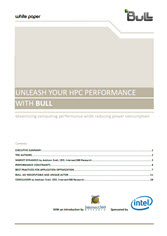
The High Performance Computing (HPC) Industry is marked by a relentless pursuit of performance, in a race to meet the demand for ever faster, more complex and more precise simulations. As a consequence, we are today in the early stages of a major transition in the prevailing HPC architecture, with the multiplication of compute cores, both in CPUs or through the addition of accelerators or coprocessors. But application designers will also have to re-think their programming and/or their algorithms to fit the new architectures and find solutions to the issue of computing and power performance.
The high performance computing industry continues to fuel new discoveries and capabilities in science, engineering, and business. At the high end, new problems are always on the horizon. There is no final frontier of science, nor an end to engineering, nor a perfect business that cannot be evolved for greater competitiveness. Our technologies are the tools that can help organizations in their perpetual drive toward innovation. For buyers in academic and government research, HPC can accelerate the path to scientific discovery. For commercial use cases, it does the same, but with the added metrics of quantifiable return on investment, as companies seek to speed time to market, improve product quality, reduce the costs of failures, and streamline operational efficiencies.
Chris Willard, Chief Research Officer of Intersect360 Research, describes the striving attitude of HPC this way: “Once you solve the problem, it’s no longer interesting. You don’t need to design the same bridge twice. You move on to the next, harder bridge.” This is the nature of the demand for ever-greater HPC performance, regardless of application.
In the relentless pursuit of performance, the HPC era has seen an evolution in the architectures deployed by the majority of the market. Vector processors gave way to scalar, RISC was supplanted by x86, and UNIX was replaced by Linux in the majority of HPC installations. Each of these transitions came with implied changes in the software models that would best leverage the hardware, in order to deliver performance at scale for real applications.
Error: Contact form not found.
All information that you supply is protected by our privacy policy. By submitting your information you agree to our Terms of Use.
* All fields required.




